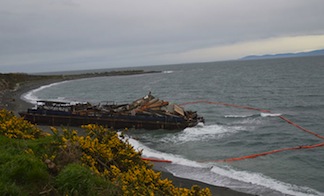The following is a news release from the Transportation Safety Board of Canada (TSB):
(RICHMOND, British Columbia) — The Transportation Safety Board of Canada (TSB) on Wednesday released its investigation report (M16P0062) into the grounding of two barges near Victoria, British Columbia. There were no injuries.
On March 2, 2016, the tug H.M. Scout departed Victoria, British Columbia, heading for Bamberton, British Columbia, with the barges HM Tacoma and HM Blue Horizon in tandem tow, one behind the other. As the tug encountered severe weather, the towline between the barges parted, resulting in HM Blue Horizon floating free and grounding near Clover Point, British Columbia. During a recovery attempt, a piece of the parted towline fouled H.M. Scout's propeller, causing the tug to be partially disabled. With reduced propulsion and HM Tacoma in tow, the tug and barge were pushed toward the shore by the sea conditions. Approximately 30 minutes later, HM Tacoma grounded while still in tow. The crew then released HM Tacoma's towline and subsequently returned to Victoria.
The investigation determined that inadequate towing equipment was used, which allowed the first barge to break free from the tow. If Transport Canada (TC) does not provide easily understandable standards and guidance to assist towing vessel owners and operators to ensure the adequacy of their towing arrangement and the condition of their towing equipment, including the selection of tow ropes, there is an increased risk of the towing equipment failing, resulting in the loss of tow.
The investigation also revealed that the company had not developed any documented operating procedures for its marine operations, and had not formally assessed the risk associated with its tug and barge operations. Despite the fact that the combined size and tonnage of the vessels may be similar to that of a conventional cargo-carrying vessel, tug and barge operations are not required to operate under a safety management system.
Although TC and WorkSafeBC both regulate marine vessel operations for their respective areas of jurisdiction, neither has an inspection program in place to routinely check that owners and operators of tugs less than 15 GT are complying with safety-critical regulations.
Safety management and oversight is a TSB Watchlist issue. The TSB has repeatedly emphasized the advantages of safety management systems (SMS), an internationally recognized framework to allow companies to effectively manage risk and make operations safer. Numerous recent investigations have found that companies have not managed their safety risks effectively. The solution will require all operators in the marine industry to have formal safety management processes, with effective oversight by TC.
Click here to read the complete report.

